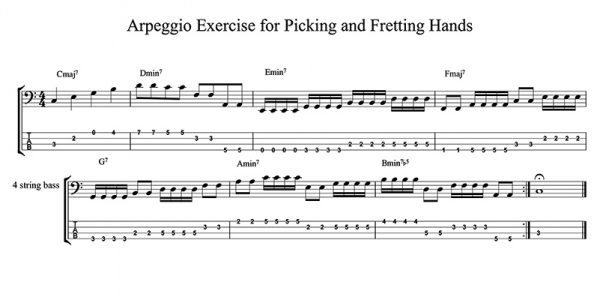Deep Thinking: An Exercise For Both Hands
Deep Thinking: An Exercise For Both Hands
An exercise for both hands with some sight reading thrown in! Over the last few NZM issues, we’ve been looking at building bass lines from modal scales and arpeggios (broken chords). This exercise is fairly simple, being in C major, but it is in a constantly varying rhythmic structure, in 4/4, and therefore gives your picking hand a good workout.
It uses the arpeggios built from C major but ‘inverts’ them (turns them upside down and varies the note order) so that they feed into each other. Bar 1 is simply four crotchets as an ascending Cmaj7 chord. Then the fun starts.
We go into quavers (eighth notes) and played an inverted (descending) Dmin7 chord starting on a high D and ending on a low A feeding nicely onto a low E in semiquavers (sixteenth notes) that ascends through E, G, B, and D making an Emin7chord. Following this, we drop back to a low F as two quavers followed by A, C, and E in alternating groups of quavers and semiquavers giving us an Fmaj7 chord.
Now that we are moving between quavers and semiquavers, we need to think about how we are picking. If you are a finger player, it doesn’t really matter if you lead with finger 1 or finger 2. I know this could potentially start an argument but I have known bassists who use both. Personally, I tend to lead with picking finger 2. The important thing is to pick evenly and smoothly. The same applies to using a pick. Whether you use up and down alternate strokes or downward strokes, keep them even.
We now drop down to a low G played as semiquavers moving up through two B quavers, D as four semiquavers, and F (the flat 7) as two quavers. This is G7. The F rises to two A quavers, rising again to four C semiquavers, then drops to two E quavers followed by four G semiquavers above the E quavers, giving us Amin7. The final chord is Bmin7b5 or B half–diminished. The G rises to four high B semiquavers that drop to two D quavers rising to four F semiquavers and falling to two A quavers. There is a repeat sign so play it all again! The exercise ends on a C semibreve (4 beats). Once you can play this (start slowly!), try it in all the other keys. Have fun and see you next time.
Dr. Rob Burns is an Honorary Associate Professor in Music at the University of Otago in Dunedin. As a former professional studio bassist in the UK, he performed and recorded with David Gilmour, Pete Townsend, Jerry Donahue, Isaac Hayes, James Burton, Ian Paice and Jon Lord, Eric Burdon and members of Abba. He played on the soundtracks on many UK television shows, such as Red Dwarf, Mr. Bean, Blackadder and Not the Nine O’Clock News. Rob is currently a member of Dunedin band, The Verlaines and is on three new progressive rock albums released in the UK in 2020 and 2021. There is a further album available on Seelie Court Records (UK) that has just been released and that Rob played on when he was 16. A live album from his teens in the 1970s was released in 2022 and is available on vinyl.


